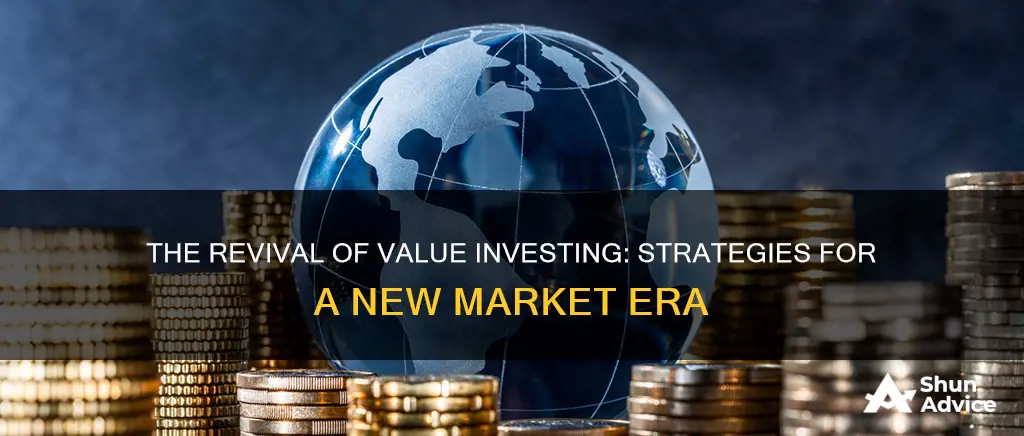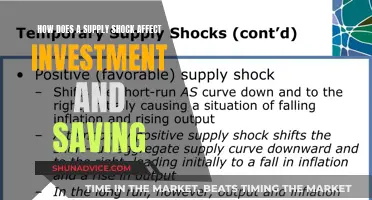
Value investing is a strategy that focuses on finding stocks that are undervalued or unloved by the market. While it has been outperformed by growth investing in recent years, there are signs that it may be making a comeback. Value stocks have seen a surge in 2024, with some analysts predicting that they could remain on top in the coming months. This comeback has been driven by geopolitical concerns and the potential for Federal Reserve rate cuts, which could make the dividends offered by value stocks more attractive. However, others argue that the AI train driving growth stocks shows no signs of slowing down. The debate surrounding the future of value investing remains divided, with some experts recommending a wait-and-see approach.
| Characteristics | Values |
|---|---|
| Returns | Value investing has historically had lower returns than growth investing. |
| Timeframe | Value investing is a long-term strategy. |
| Risk | Value investing carries less risk than growth investing. |
| Market cycles | Value investing and growth investing move in cycles. |
| Investor behaviour | Investor enthusiasm is contagious but eventually wears out. |
| Interest rates | Rising interest rates may lead to a recovery in value stocks. |
| Economic growth | Strong economic growth can drive value stocks higher. |
| Stock selection | Value investing requires identifying underappreciated and undervalued stocks. |
| Industry differences | Value indices have a higher concentration of financials and energy stocks. |
| Business models | Technological disruption can impact the performance of value stocks. |
| Investor patience | Value investing requires a long-term perspective and patience. |
What You'll Learn

Value investing vs growth investing
Overview
Value investing and growth investing are two primary investment strategies. Value investing targets undervalued stocks, while growth investing focuses on companies with strong growth potential. Both strategies have their advantages and considerations, and investors often debate which approach is superior.
Value Investing
Value investors seek out stocks that are considered undervalued or trading below their intrinsic value. These stocks typically belong to larger, more established companies with steady profits. Value stocks are usually priced lower than the broader market and may offer dividends. Examples of value stocks include Berkshire Hathaway, JPMorgan Chase, and Proctor & Gamble.
Growth Investing
Growth investing, on the other hand, involves investing in young, early-stage companies experiencing rapid growth in profits, revenue, or cash flow. Growth investors are willing to pay a premium for these stocks, expecting sustained capital appreciation. Growth stocks often refrain from paying dividends, instead reinvesting profits back into the company for further growth. Examples of growth stocks include Meta Platforms (formerly Facebook), Amazon, and Tesla.
Performance Comparison
Historically, value investing has outperformed growth investing over the long term. However, in recent years, growth investing has taken the lead. Since 1995, growth mutual funds have returned 1,072%, while value mutual funds have returned 624%.
Factors to Consider
The choice between value and growth investing depends on various factors, including an investor's time horizon, risk tolerance, and investment goals. Value investing is generally considered lower risk due to the established nature of the companies involved. Growth investing, on the other hand, carries more risk but also offers the potential for higher rewards.
Additionally, market conditions play a role. Value investing often performs better during bear markets and economic recessions, while growth investing excels during bull markets and periods of economic expansion.
Both value and growth investing strategies have their merits, and some investors choose to adopt a blended approach, investing in companies that fall into both categories. The best strategy may depend on market conditions, an investor's risk appetite, and their investment time horizon.
Pay Off Loans or Invest: Navigating the Pros and Cons for Your Financial Future
You may want to see also

The role of interest rates
Interest rates play a crucial role in shaping the investment landscape, and their impact on value investing is significant. Generally, interest rates and stock markets share an inverse relationship. When interest rates increase, share prices tend to fall, and vice versa. This is because higher interest rates make borrowing more expensive for companies, reducing their cash flow stability and leaving less money to reinvest in their business, which typically puts pressure on their share prices.
The Federal Open Market Committee's (FOMC) decisions on interest rates have immediate consequences for stock markets and more gradual effects on the broader economy. The FOMC's actions influence the federal funds rate, which is the rate that depository institutions charge each other for overnight loans. By adjusting this rate, the Federal Reserve can control the supply of money available for purchases, making it more or less expensive to obtain.
The federal funds rate also forms the basis for various consumer and business loan rates, including mortgage loan rates and credit card annual percentage rates (APRs). Therefore, when the federal funds rate increases, it has a ripple effect on the borrowing costs for companies and consumers. Higher interest rates can lead to reduced consumer spending, impacting businesses' revenues and profits, which, in turn, can affect their stock prices.
However, it's important to note that interest rates are just one of many factors influencing stock market performance. Other factors, such as corporate earnings, economic growth, and consumer spending, also play a crucial role in driving stock market trends.
Regarding the potential comeback of value investing, it's worth noting that interest rate changes have historically been uncorrelated to future equity value factor performance. While higher interest rates can make growth stocks less attractive due to reduced access to cheap capital, they may not necessarily impede the overall value investing strategy.
In summary, while interest rates can influence the performance of value stocks, the relationship is complex and subject to various other economic factors. The role of interest rates in the potential comeback of value investing is, therefore, one piece of a larger puzzle that includes corporate earnings, economic growth, consumer behaviour, and other investment strategies.
Car Claims: The Billion-Dollar Investment Question
You may want to see also

The impact of economic growth
Economic growth is an increase in the production of goods and services in an economy. It can be measured in nominal or real terms and is often measured in terms of the gross national product (GNP) or gross domestic product (GDP). Economic growth is dependent on four contributory areas:
- An increase in physical capital goods, such as capital investment in real estate, manufacturing plants, machinery, computers, vehicles, and production equipment.
- Improvements in technology, such as the invention of gasoline fuel, which can increase productivity and create new goods and services.
- Growth of the labour force, which can generate more economic goods and services.
- An increase in human capital, such as labourers becoming more skilled at their crafts, which can raise productivity.
Economic growth can have a positive impact on value investing by increasing the production of goods and services, which can lead to higher profits for companies. This, in turn, can drive up stock prices and create more investment opportunities. Additionally, economic growth can lead to higher consumer spending, which can benefit value companies as they tend to do well when the entire economy grows.
However, it is important to note that the impact of economic growth on value investing is complex and can be influenced by various factors, such as interest rates, government spending, and tax policies. For example, high-interest rates may discourage capital investment, while tax cuts may have a limited impact on spurring economic growth compared to increases in government spending.
In conclusion, economic growth can have a positive impact on value investing by increasing production, consumer spending, and investment opportunities. However, the relationship between economic growth and value investing is multifaceted and subject to various economic factors.
Assessing the Investment Strategy: A Comprehensive Guide to Evaluating New Ventures
You may want to see also

Technological disruption
The rise of technology giants like Amazon, Facebook, and Uber has disrupted traditional businesses, such as brick-and-mortar retail, and shifted demand online. This has resulted in the decline of many well-established companies that value investors typically favour. Additionally, the COVID-19 pandemic has accelerated this disruption, with many physical businesses struggling to survive.
Value investing has been in a prolonged drawdown, with underperformance for over a decade. This has called into question the long-held beliefs of value investing, which is based on the idea that value stocks trading below their intrinsic value will outperform the market. However, the recent performance of value stocks has been disappointing, with massive losses during the pandemic.
The underperformance of value investing is attributed to its massive short bet against technological disruption. Value investors tend to favour companies with strong assets and track records of past performance. In contrast, tech disruptors focus on reinvesting in new technologies, business models, and intellectual property, which may reduce near-term profits.
Additionally, the fast-changing nature of the tech sector makes it difficult for value investors to keep up. Tectonic shifts occur frequently in technology, and companies that once dominated the market can quickly become obsolete. The S-curve, a visual representation of the growth path of tech companies, highlights how they can go from rapid growth to commoditization over time.
To adapt to the changing landscape, value investors need to evolve their framework. They should consider the potential for technological disruption in different industries and adjust their measures of intrinsic value. Additionally, they should focus on identifying companies that can leverage technology to gain an edge over their competitors.
While some analysts predict a renaissance for value investing, it remains to be seen whether this will be a durable trend or another head fake. In the current market, dominated by growth momentum and a handful of tech giants, value investors face a challenging task to identify opportunities and adapt their strategies.
Invest Now: Where to Put Your Money
You may want to see also

Investor behaviour
Rational Actor Theory (RAT)
The Rational Actor Theory, a cornerstone of traditional economic thinking, posits that individuals make decisions based on rational calculations aimed at maximising their utility or self-interest. However, behavioural finance researchers have questioned these assumptions, finding evidence of systematic deviations from rational behaviour.
Fear of Regret
One example of irrational investor behaviour is the "fear of regret". Investors often avoid selling a stock that has declined in value due to the emotional attachment to the price they initially paid. This behaviour can lead to a vicious cycle where investors hold on to losing stocks, hoping to avoid the regret of realising a loss.
Mental Accounting
Mental accounting refers to the tendency of individuals to compartmentalise financial decisions. For example, investors may hesitate to sell an investment that previously had significant gains but now only has modest returns. They create mental compartments for the past gains, causing them to delay selling in hopes of recapturing those higher profits.
Prospect Theory and Loss Aversion
Prospect theory suggests that individuals experience greater stress from potential losses than they do happiness from equivalent gains. This can lead to investors holding on to losing stocks, as they are more willing to take risks to avoid losses than to realise gains.
Overconfidence
Investor overconfidence is another common behavioural bias. Many investors believe they can consistently time the market, leading to excessive trading and higher costs. This overconfidence can result in sub-optimal investment decisions and lower returns.
Social and Cultural Influences
Behavioural economics initially focused on cognitive psychology to explain investor behaviour. However, more recent research has identified social and cultural forces that also play a significant role. For instance, people tend to be more conservative when making investment decisions for close others or when investing in accounts with culturally-salient labels such as "retirement".
Implications for Value Investing
The inefficiencies and irrational behaviours identified by behavioural finance have important implications for value investing. Value investors seek to exploit market inefficiencies by identifying undervalued stocks. By understanding investor biases, value investors can make more informed decisions and potentially profit from mispriced securities.
However, it is challenging to consistently identify and exploit these inefficiencies. Value investing requires diligence, patience, and a long-term outlook. Short-term market fluctuations and investor herding behaviours can obscure the true intrinsic value of stocks, making it difficult for value investors to capitalise on these opportunities.
Smart Ways to Invest $1,000 Right Now
You may want to see also
Frequently asked questions
Value investing is a strategy where investors seek out and buy undervalued stocks. Value stocks are generally out of favour, less flashy, and accumulate profits more slowly. Investors pay fewer dollars for every dollar of a value stock's earnings, revenues and net assets.
Value investing has been outperformed by growth investing in recent years. Returns to value investing have fallen sharply since the 1990s. This may be because value investing is now more mainstream and more widely documented, reducing its effectiveness.
It's hard to say. Some experts believe that rising interest rates may reverse the trend and make value investing more attractive. However, others argue that technological disruption and changes in business models may continue to favour growth investing.







